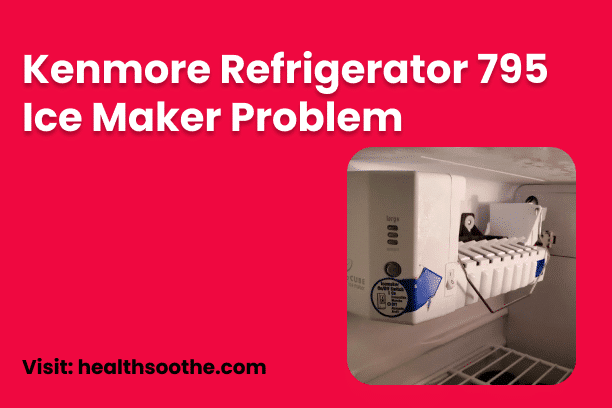The Kenmore 795 refrigerator is renowned for its efficient ice production and overall quality. However, as time passes, the ice maker may encounter a range of mechanical issues that can be addressed. If you suspect that your Kenmore Refrigerator 795 ice maker is experiencing problems but are unable to identify the specific issue, there are several common problems to consider.
These issues encompass leaks, the ice maker failing to dispense or produce ice, or dispensing either too little or too much ice. Additionally, the ice maker may exhibit slow dispensing, fail to fill with water, freeze up, or suddenly stop functioning.
The advantage is that many of these ice maker problems can be resolved. Some may necessitate actions such as clearing a blocked drain line, replacing a filter, thawing frozen components, or adjusting the temperature settings. In the following sections, I will delve into these nine issues in detail, providing you with the information needed to pinpoint the precise problem with your Kenmore Refrigerator 795 ice maker and address it accordingly.
Diagnosing Your Kenmore Refrigerator 795 Ice Maker Problem and Fixing It
1. Kenmore Elite 795 Ice Maker Leaking
Dealing with a leaking ice maker can be quite frustrating, especially in the context of the Kenmore refrigerator 795, where the leakage may occur in the freezer, ice bucket, ice bin, or even on the floor. Here are the potential causes of this issue and their respective solutions:
a) Faulty Fill Tube: The Kenmore ice maker relies on a fill tube to receive water. If this fill tube malfunctions, it can't properly fill the ice maker, leading to water leakage into the freezer.
Solution: Replace the fill tube in the ice bucket if it is found to be faulty.
b) Frosted Fill Tube: Sometimes, the fill tube may be in working order but is obstructed by ice, preventing water from reaching the ice maker and causing it to leak onto the floor.
Solution: To unfreeze the fill tube, you can either run hot water through it or turn off the refrigerator unit and leave its door open for approximately 30 minutes, allowing the ice to naturally melt.
c) Drain Clogging: Accumulated dirt in the condenser drains over time can lead to clogs. When this happens, water may start leaking into the freezer.
Solution: Clean the condensation drains, which are typically located at the base of the freezer.
d) Expired Filter: The filter's role is to purify water before it enters the ice maker, and if it's faulty, it can contribute to the leakage issue.
Solution: Check the filter's expiration date and replace it if it has expired.
e) Ice Jam: In a lower freezer temperature environment, the ice in the ice bucket can clump together, creating a large mass that leads to leakage into the ice bin.
Solution: Unplug the refrigerator unit and remove the ice mass. Alternatively, leave the freezer open for approximately 30 minutes at room temperature to allow the ice to thaw.
f) Low Water Pressure: Your ice maker requires a minimum of 20 psi water pressure to operate effectively. If the pressure drops below this level, the ice maker may overfill and leak.
Solution: Adjust your home's water pressure or replace the existing valve with a low-pressure option to ensure proper water supply to the ice maker.
2. Slow Kenmore Refrigerator 795 Ice Maker
When your ice maker dispenses ice at a slow pace, it can be quite frustrating. Here are some potential issues to consider:
a) High Temperature: The temperature within your Kenmore ice maker should ideally be around 12°F. If it deviates from this range, it can significantly slow down the ice production process.
Solution: Adjust the freezer's temperature settings to maintain it at around 12°F.
b) Faulty Water Line: Examine the waterline in your unit for any signs of ice or dirt clogging or kinks that may be obstructing water flow.
Solution: Clear any clogs, ice build-up, or kinks from the water line to ensure proper water supply.
c) Blocked Water Filter: A water filter that is clogged with dirt can restrict water flow to the ice maker, causing a slowdown in ice production.
Solution: Replace the water filter if it is clogged and no longer functioning effectively.
d) Overstocking or Understocking: Overloading or underloading your Kenmore refrigerator can force it to work harder to maintain the desired temperature, which in turn can slow down the ice-making process.
Solution: Avoid overloading or underloading your Kenmore fridge to maintain optimal cooling conditions and ice production efficiency.
3. Kenmore Refrigerator 795 Ice Maker Not Making Ice
When your ice maker isn't producing any ice, there could be several potential causes to investigate:
a) Frozen Line or Evaporator Coil: If there's an ice buildup on the waterline or evaporator coil, it can prevent the ice maker from functioning.
Solution: Thaw and clear the ice buildup from both the waterline and evaporator coil to restore normal function.
b) Clogged Water Filter: A clogged water filter not only fails to filter impurities but also hampers the ice maker's water supply and ice production.
Solution: Replace the clogged water filter to improve water supply and ice production.
c) Faulty Water Inlet Valve: A malfunctioning water inlet valve, whether due to electrical or mechanical issues, can disrupt the ice maker's operation.
Solution: Check for faults in the water inlet valve using a multimeter and replace it if it is found to be faulty.
d) Incorrect Temperature Setting: Inappropriate temperature settings in the ice maker can lead to a lack of ice production. It should ideally be set at around 12°F.
Solution: Adjust the ice maker's temperature settings to maintain it at approximately 12°F to encourage ice production.
e) Defective Thermostat: A malfunctioning thermostat that is unresponsive can hinder the ice maker's operation.
Solution: Replace the defective thermostat to restore normal function.
f) Failing Ice Maker: If the ice maker is significantly old or has sustained significant damage, it may be prone to failure. The sensors and the inside arm of the ice maker are crucial components that, if malfunctioning, can lead to overall unit malfunction.
Solution: Consider replacing your Kenmore ice maker if it is old, badly damaged, or if essential components like sensors and the inside arm are failing to function properly.
Pros and Cons of Kenmore Refrigerator
Pros
- Can maintain consistent temperatures
- Crisper can maintain humidity levels
- Reliability
Cons
- Energy inefficient
- Noise Levels
- Cost
Difference Between Kenmore Refrigerator and Kenmore Elite?
Kenmore Refrigerators
These are typically more budget-friendly and cater to a wide range of consumers. They offer basic features and functionality without the premium price tag.
Kenmore Elite Refrigerators
Kenmore Elite appliances are known for their higher quality, advanced features, and premium materials. They often come with innovative technology and design elements, making them more expensive than standard Kenmore models.
Alternative to Kenmore Refrigerator
LG:
LG produces stylish and feature-rich refrigerators with options like InstaView door-in-door access, Wi-Fi connectivity, and SmartThinQ technology. They offer a variety of styles and sizes to suit different kitchen layouts.
4. Kenmore Refrigerator 795 Ice Maker Freezing Up
When your ice maker freezes up, it can be due to various reasons, including:
a) Inadequate Water Supply: Insufficient water supply to the ice tray can lead to a failure in the sensor's detection, resulting in overfilling of the tray and subsequent freezing.
Solution: Improve the water supply to the ice tray to ensure that it receives an adequate amount of water.
b) Door Not Shutting Well: If the freezer door on your Kenmore refrigerator doesn't close properly, warm air can enter the freezer, causing the ice to briefly thaw and then refreeze.
Solution: Ensure that the freezer door is fixed and closed completely to prevent warm air from entering and causing ice to melt and refreeze.
Conclusion
In conclusion, addressing a Kenmore Refrigerator 795 ice maker problem requires a systematic approach to identifying and resolving the underlying issues. Whether it's dealing with leaks, slow ice production, a malfunctioning ice maker, or freezing problems, understanding the potential causes and their respective fixes is essential. By maintaining proper temperature settings, checking the water supply, ensuring the freezer door is properly sealed, and addressing any faulty components such as water filters, valves, or thermostats, you can effectively troubleshoot and resolve ice maker problems in your Kenmore refrigerator 795. Regular maintenance and timely repairs can help ensure that your ice maker operates efficiently and provides a consistent supply of ice for your needs.

